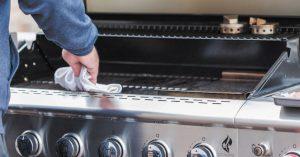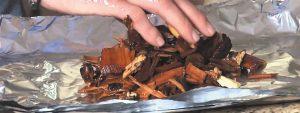1. Cleaning Your Grill
 Before you begin grilling, make sure your grill is clean since food will stick to particles that you leave on your grid. Grill manufacturers recommend deep cleaning your grill at least once a year. A deep cleaning includes: removing and scrubbing the grates, cleaning the grill components under the grates, wiping out the interior of the lid, and then wiping down the outside of the grill.
Before you begin grilling, make sure your grill is clean since food will stick to particles that you leave on your grid. Grill manufacturers recommend deep cleaning your grill at least once a year. A deep cleaning includes: removing and scrubbing the grates, cleaning the grill components under the grates, wiping out the interior of the lid, and then wiping down the outside of the grill.
2. Starting Your Grill
Propane is the most common type of fuel for gas grills. Before trying to start your grill, check your fuel tank. Make sure the propane tank is connected and the valve is open. Once that is done, turn on the burner you will be using, and light the grill. Make sure that you preheat your grill for at least 10 to 15 minutes (gas grills take less time to preheat than charcoal).
3. Cooking on Your Grill
 Make sure the burners on one side of the grill are set to medium or medium-high and the other side is set to medium-low or low so you are able to cook the meat all the way through without burning it. You can sear the meat on the high end and cook it through to the center on the other end. Once you take the meat off the grill, let it rest for a little while. Direct heat comes from the burners that are set to the highest temperature (high or medium-high), and it is best for searing your food. Indirect heat comes from a burner next to the direct heat source that is turned off. This can be used so your food can cook slowly and thoroughly without burning the outsides of it. The lid is important to know how to use. Keeping it closed can have more of a baking effect on your food. However, it is also easy to overcook your food with the lid closed since it can make the environment hotter. The top rack on your grill could be great for melting cheese on your burgers, toasting buns, or warming up side dishes. You must watch your food closely when grilling anything.
Make sure the burners on one side of the grill are set to medium or medium-high and the other side is set to medium-low or low so you are able to cook the meat all the way through without burning it. You can sear the meat on the high end and cook it through to the center on the other end. Once you take the meat off the grill, let it rest for a little while. Direct heat comes from the burners that are set to the highest temperature (high or medium-high), and it is best for searing your food. Indirect heat comes from a burner next to the direct heat source that is turned off. This can be used so your food can cook slowly and thoroughly without burning the outsides of it. The lid is important to know how to use. Keeping it closed can have more of a baking effect on your food. However, it is also easy to overcook your food with the lid closed since it can make the environment hotter. The top rack on your grill could be great for melting cheese on your burgers, toasting buns, or warming up side dishes. You must watch your food closely when grilling anything.
4. Cooking Temp and Tools to Use with Your Grill
 For grilling with a gas grill, here are some tools that are helpful. To make sure your meat is properly cooked all the way through, you should have a thermometer. When grilling, looks can be deceiving and it may seem like your food is cooked all the way through when it’s not. A thermometer is a good way to check if your food is safe to eat. Know what temperature your meats should be cooked to for them to be edible; for example, steak should be at least 145°F for it to be considered medium. Your chicken’s internal temperature should be at least 165°F. Long tongs are safer than just oven mitts when it comes to grilling and will be more effective when removing or flipping your food. Skewers or grill baskets can help you cook items at the same time; for example, vegetables and shrimp can be skewered or tossed in a grill basket and cooked to perfection.
For grilling with a gas grill, here are some tools that are helpful. To make sure your meat is properly cooked all the way through, you should have a thermometer. When grilling, looks can be deceiving and it may seem like your food is cooked all the way through when it’s not. A thermometer is a good way to check if your food is safe to eat. Know what temperature your meats should be cooked to for them to be edible; for example, steak should be at least 145°F for it to be considered medium. Your chicken’s internal temperature should be at least 165°F. Long tongs are safer than just oven mitts when it comes to grilling and will be more effective when removing or flipping your food. Skewers or grill baskets can help you cook items at the same time; for example, vegetables and shrimp can be skewered or tossed in a grill basket and cooked to perfection.
5. Smoking on Your Grill
 If you want to smoke food on your grill, there is a way to do so with a gas grill. You can use hardwood pellets in different ways to get the smoky taste.
If you want to smoke food on your grill, there is a way to do so with a gas grill. You can use hardwood pellets in different ways to get the smoky taste.
- Sprinkle – You can sprinkle a large handful of hardwood pellets under the grates and close the lid.
- Tin foil method – Wrap a large handful of hardwood pellets in tin foil, poke a few holes into the tin foil, place it under the grates, and close the lid.
You can also infuse your food with herbs by placing bunches of herbs under the grates as well.
Grilling is something that every family wants to do from time to time. Whether it’s for holidays, for guests, or just for your family, it gives your food a different flavor that people across the world love to enjoy. Grilling is not as hard as it seems once you break down how the grill itself works. Follow these tips, and you’re on your way to mastering the grill! ![]()
Kamilah Williamson
Home & Yard Magazine




